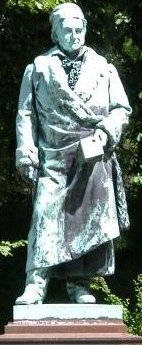| Carl Friedrich Gauss (30 April 1777- 22 February 1855) |
Childhood
|
|
|
| Bibliography |
|
To begin a biography, which is
simply a written history of a person’s life, it seems necessary to
start at
birth if such information is known. So, to begin Carl Friedrich Gauss
was born
on April 30, 1777 in what is now Brunswick, Germany. He was born an
only son to
parents of a lower class Family. As the story goes signs of his genius
started
to be noticed at very early on in his childhood. When he was only three
years
old it is said that while watching his father do finances on a sheet of
paper,
he caught an error made by his father and corrected it. One of the most
reoccurring stories of his childhood, which many would argue, really
solidifies
his case for being a child prodigy come from primary school. One day to
occupy
students the instructor gave Gauss and his pupils the task of adding
all the
integers from 1 to 100 surely thinking that it would be beneficial and
a
challenge for students who were still at a beginner’s level in
practicing
their
mathematical skills. Within seconds of posing the question Gauss had
figured
out the answer proclaiming “ligget se” (there it lies). Amazed that the
answer
was simply written on the slate and nothing else the instructor ask
Gauss how
he arrived at the result. The explanation followed: 1+ 100 =101, 2+ 99
=101,
and so on until 49+ 52 =101and 50+ 51 =101. This is a total of 50 pairs
of
numbers, each which add up to 101 meaning the total sum is 50 * 101 =
5050.
Basically Gauss found the symmetry property of arithmetic progressions
by
grouping the terms together. Following this display of brilliance from
the
child the instructor realized that he could not teach anything to Gauss
so he
special ordered a book from Hamburg and allowed his 18 year old
assistant, who
later became a professor of mathematics, guide and mentor him. This symbolic event was the sign of great
things to come. The great German mathematician and scientist would be
remembered at the end of his life for his incredible contributions to
many
field in science and math such as numbers
theory, differential
geometry, analysis,
geodesy,
magnetism,
optics
and, astronomy. |
Statue of Gauss in Brunswick  http://en.wikipedia.org/wiki/ Image:Gauss_Statue.jpg |